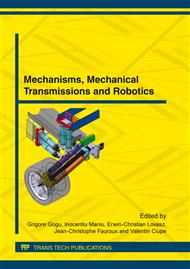[1]
M. K. Habib, Bioinspiration and Robotics. Walking and Climbing Robots, InTech , Vienna, (2007).
Google Scholar
[2]
I. Maniu, C. Rădulescu, I. Bogdanov, S. Varga, V. Dolga, V. Ciupe, Robotics. Robotic applications, Ed. Politehnica, Timisoara, (2009).
Google Scholar
[3]
E. Garcia, J. Estremera and P. Gonzalez de Santos, A comparative study of stability margins for walking machines, Robotica, Vol. 20, No. 6, pp.595-606, (2002).
DOI: 10.1017/s0263574702004502
Google Scholar
[4]
G. Roberts, Intelligent mechatronics, Comput. Control Eng. J. - December Volume 9, Issue 6, p.257–264, (1998).
Google Scholar
[5]
V. Dolga, Mechatronics systems design, Ed. Politehnica, Timisoara, (2007).
Google Scholar
[6]
F. Dudita, D. Diaconescu, Structural optimization of mechanisms, Ed. Tehnica, Bucuresti, (1987).
Google Scholar
[7]
V. Handra-Luca, Transmission functions in the study of linkages, Ed. Academia Romana, Bucuresti, (1983).
Google Scholar
[8]
J. A. Cobano, J. Estremera and P. Gonzalez de Santos, Location of legged robots in outdoor environments, Robotics and Autonomous Systems, Vol. 56, pp: 751-761, (2008).
DOI: 10.1016/j.robot.2007.12.003
Google Scholar
[9]
M. Hackel, Humanoid Robots. Human-like machines, I-Tech, Vienna, (2007).
Google Scholar
[10]
P. Gonzalez de Santos, E. Garcia and J. Estremera, Quadrupedal locomotion: An Introduction to the Control of Four-Legged Robots, Springer, London, (2006).
Google Scholar
[11]
N. E. N. Rodriguez, C. Carbone,M. Ceccarelli, Simulating CALUMA (CAssino Low-cost hUMAnoid) robot carrying a load, Applied Bionics and Biomechanics, Volume 4, Issue 1, pp.1-8, (2007).
DOI: 10.1080/11762320701403880
Google Scholar
[12]
A.J. Ingram, A new type of walking machine. thesis, University of Johannesburg, (2006).
Google Scholar
[13]
D. Giesbrecht, C. Wu Qiong, Dynamics of Legged Walking Mechanism Wind Beast, Department of Mechanical and Manufacturing, Engineering, University of Manitoba, California, (2010).
Google Scholar
[14]
T. Jansen T, http: /www. strandbeest. com/. Accessed: 2011-03-01.
Google Scholar
[15]
Matlab SimMechanics, http: /www. mathworks. com/help/toolbox/physmod/mech.
Google Scholar
[16]
U.S. Chavan, S.V. Joshi, Synthesis and analysis of coupler curves with combined planar cam follower mechanisms, International Journal of Engineering, Science and Technology Vol. 2, No. 6, pp.231-243, (2010).
DOI: 10.1109/iccet.2010.5486260
Google Scholar


